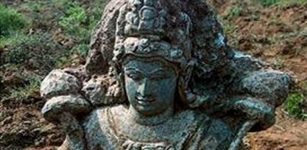Old Babylonian Residential Building In Ur Dated To 1835 BC – Investigated
Conny Waters - AncientPages.com - Ur is one of the world’s oldest cities. What was life like for its inhabitants some 4000 years ago?
During this year's season at Ur, archaeologists focused on a residential building that was located on the edge of the city, and has been dated to the period around 1835 BC.
 The bathroom, which was tiled, and also the drain, which led a depth of several meters. Credit: A. Otto/LMU; Berthold Einwag
The bathroom, which was tiled, and also the drain, which led a depth of several meters. Credit: A. Otto/LMU; Berthold Einwag
Archaeologists unearthed the whole house, together with a vaulted tom with the remains of 24 individuals. The uncovered house contains 17-rooms, a large courtyard, and the surviving inventory.
“The question we originally wanted to answer was whether the poorer class of people lived on the periphery of the city, since excavations in the city center have revealed that its residential population was clearly well off," Adelheid Otto, Director of the Institute of Near Eastern Archaeology at LMU, said in a press release.
"But instead of finding lower-class dwellings, we came upon this Old Babylonian villa. It was certainly a very imposing building. We have been able to identify the function of each of its rooms, and the finds give a very detailed and precise picture of how its inhabitants lived nearly 4000 years ago. Even the kitchen and a bathroom complete with toilet and a drainage system are preserved. Indeed, in terms of hygiene, the arrangements were excellent. Thanks to the finds made during the excavation, it is now possible to piece together how the inhabitants led their lives."
Inscribed clay tablets and unrolled seals are among this year's excavations at the site of Ur. Credit: A. Otto/LMU; Berthold Einwag
“It is the very model of a private residence in the Old Babylonian period.”
Now, researchers know who was the owner. His name was Sîn-nada, and he was essentially high priest and managing director of the second most important temple in Ur, an office which made him a personage of considerable consequence in the city.
“Interestingly, it turns out that his wife was also involved in the administration of the temple. In Ur during this period, women could also read and write,” the researcher informed.
Based on the human remains, which are still analyzed, one can preliminary say that these people "were healthy and well nourished, and some of them survived for 70 years and more. More detailed study should yield further information on what they ate, how long they lived and how healthy they were, and should also tell us whether or not they were related to each other, and whether they were natives of Ur or had moved to the city from elsewhere. Ur was a trading center, so it is likely that many of its inhabitants came from further afield," said Otto.
The remains of a house on the periphery of the city, containing 17 rooms. It belonged to the Administrator and Chief Priest of Ur’s second most important temple, a prominent member of the city’s elite. Credit: A. Otto/LMU; Berthold Einwag.
So far, the investigations at Ur have demonstrated that, 4000 years ago, the city was a lively and densely settled metropolis. “It was a flourishing period during which people generally had a good life. That is certainly what this house and its residents tell us.”
Its owner Sîn-nada and his family led prosperous lives almost a century before the city itself met its end. Its fate was sealed when the city’s population revolted against the King of Babylonia, who had gained control of the city.
The King responded by cutting off the city’s water supply by rerouting the course of the Euphrates. Ur found itself, as it is today, in the middle of a dry steppe, and urban life eventually became impossible, says Adelheid Otto, and goes on to point out the relevance of this tragedy to the threats we face today from climate change. Within a very short time, the shortage of water turned this prosperous city into a pile of sand. By about 1720 BCE, Ur ceased to exist, and it was only hundreds of years later that life at Ur was resuming again.
The excavation forms part of a larger project led by Professor Elisabeth Stone of Stony Brook University in New York State.
Written by Conny Waters - AncientPages.com Staff Writer






















